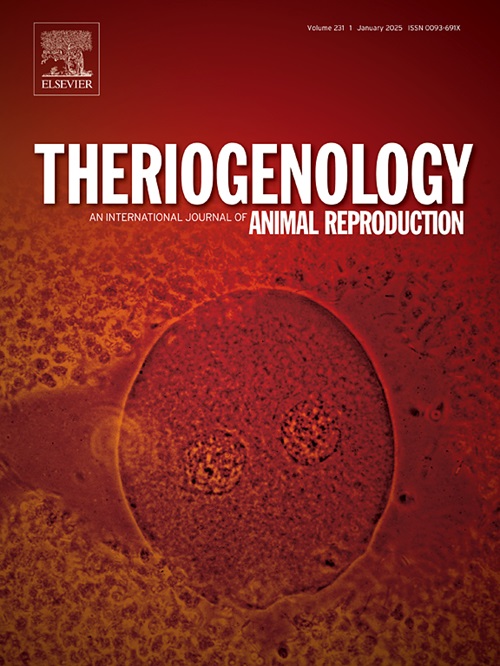利用一种新的三维培养系统促进小鼠未成熟卵母细胞的成熟
IF 2.4
2区 农林科学
Q3 REPRODUCTIVE BIOLOGY
引用次数: 0
摘要
未成熟卵母细胞的有效利用有望提高低卵巢储备妇女的受孕率。卵母细胞微环境包括细胞外基质和细胞间与体细胞的交流,是支持卵母细胞成熟的关键。本研究假设,利用细胞外基质主要成分层粘胶蛋白修饰的水凝胶和成熟小鼠卵母细胞的颗粒细胞构建三维(3D)培养体系,可以复制卵母细胞成熟所需的生物力学微环境,从而促进未成熟小鼠卵母细胞的发育。为了验证这一假设,我们初步评估了水凝胶的物理性质,并确定了体外培养卵母细胞的最佳浓度。取生发囊(GV)期小鼠卵母细胞304个,随机分为二维(2D)、三维(3D)和3D- gcs培养组。3d - gc组第一极体挤压率最高(83.1±5.0%)。通过DCFH-DA和JC-1染色评估氧化应激水平和线粒体膜电位,证实3D培养显著降低氧化应激,增强线粒体活性。通过皮质颗粒分布和内质网组织来评估细胞质成熟度,进一步突出了3d - gc系统的优势。3D-GCs组显示87.7%的卵母细胞具有III级皮质颗粒分布,84.6%的卵母细胞具有成熟的内质网,显著高于其他组(p <;0.05)。总之,3D-GCs培养系统有效地支持了未成熟卵母细胞核和细胞质的同步成熟。这种方法为提高卵母细胞的发育能力提供了一个有希望的平台,可能有益于卵巢储备功能减退的女性。本文章由计算机程序翻译,如有差异,请以英文原文为准。
Enhanced maturation of mouse immature oocytes using a novel three-dimensional culture system
The effective utilization of immature oocytes holds promise for improving conception rates in women with low ovarian reserve. The oocyte microenvironment, comprising the extracellular matrix and intercellular communication with somatic cells, is crucial for supporting oocyte maturation. This study hypothesizes that a three-dimensional (3D) culture system, constructed with hydrogels modified by laminin-mimetic peptides—a major component of the extracellular matrix—and granulosa cells (GCs) from mature mouse oocytes, can replicate the biomechanical microenvironment required for oocyte maturation, thereby promoting the development of immature mouse oocytes. To validate this hypothesis, we initially assessed the physical properties of hydrogels and determined the optimal concentration for in vitro oocyte culture. A total of 304 germinal vesicle (GV) phase mouse oocytes were retrieved and randomly allocated to two-dimensional (2D), 3D, and 3D-GCs culture groups. The 3D-GCs group exhibited the highest rate of first polar body extrusion (83.1 ± 5.0 %). Oxidative stress levels and mitochondrial membrane potential were evaluated using DCFH-DA and JC-1 staining, confirming that 3D culture significantly reduced oxidative stress and enhanced mitochondrial activity. Cytoplasmic maturation, assessed by cortical granule distribution and endoplasmic reticulum organization, further highlighted the superiority of the 3D-GCs system. The 3D-GCs group demonstrated 87.0 % of oocytes with grade III cortical granule distribution and 84.6 % with mature endoplasmic reticulum, significantly surpassing the other groups (p < 0.05). In conclusion, the 3D-GCs culture system effectively supports synchronized nuclear and cytoplasmic maturation in immature oocytes. This approach provides a promising platform for improving the developmental competence of oocytes, potentially benefiting women with diminished ovarian reserve.
求助全文
通过发布文献求助,成功后即可免费获取论文全文。
去求助
来源期刊

Theriogenology
农林科学-生殖生物学
CiteScore
5.50
自引率
14.30%
发文量
387
审稿时长
72 days
期刊介绍:
Theriogenology provides an international forum for researchers, clinicians, and industry professionals in animal reproductive biology. This acclaimed journal publishes articles on a wide range of topics in reproductive and developmental biology, of domestic mammal, avian, and aquatic species as well as wild species which are the object of veterinary care in research or conservation programs.
 求助内容:
求助内容: 应助结果提醒方式:
应助结果提醒方式:


